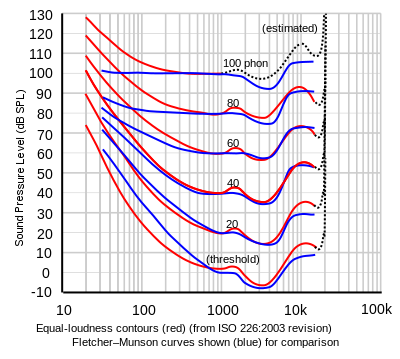Fletcher–Munson curves
It has been suggested that this article be merged into Equal-loudness contour. (Discuss) Proposed since April 2018. |
The Fletcher–Munson curves are one of many sets of equal-loudness contours for the human ear, determined experimentally by Harvey Fletcher and Wilden A. Munson, and reported in a 1933 paper entitled "Loudness, its definition, measurement and calculation" in the Journal of the Acoustical Society of America.[1]
Background[edit]
The first research on the topic of how the ear hears different frequencies at different levels was conducted by Fletcher and Munson in 1933. Until recently, it was common to see the term Fletcher–Munson used to refer to equal-loudness contours generally, even though a re-determination was carried out by Robinson and Dadson in 1956, which became the basis for an ISO 226 standard.
It is now better to use the generic term equal-loudness contours, of which the Fletcher-Munsons curves are now a sub-set,[2] and especially since a 2003 survey by ISO redefined the curves in a new standard.[3]
According to the ISO report, the Robinson–Dadson results were the odd one out, differing more from the current standard than did the Fletcher Munson curves. The report states that it is fortunate that the 40-phon Fletcher–Munson curve on which the A-weighting standard was based turns out to have been in agreement with modern determinations.
The article also comments on the large differences apparent in the low-frequency region, which remain unexplained. Possible explanations are:
- The equipment used was not properly calibrated.
- The criteria used for judging equal loudness at different frequencies had differed.
- Subjects were not properly rested for days in advance, or were exposed to loud noise in traveling to the tests which tensed the tensor tympani and stapedius muscles controlling low-frequency mechanical coupling.
See also[edit]
- A-weighting
- Audio quality measurement
- ITU-R 468 noise weighting
- Listener fatigue
- Mel scale
- Robinson–Dadson curves
- Weighting filter
References[edit]
- ^ Fletcher, H. and Munson, W.A. "Loudness, its definition, measurement and calculation", Journal of the Acoustical Society of America 5, 82-108 (1933).
- ^ "Fletcher Munson Curve: The Equal Loudness Contour of Human Hearing". Ledger Note. Retrieved November 17, 2017.
- ^ ISO 226:2003 (PDF), archived from the original (PDF) on September 27, 2007

